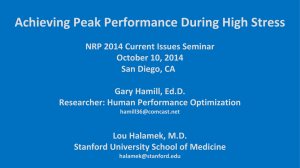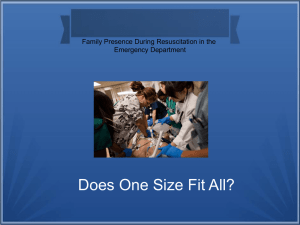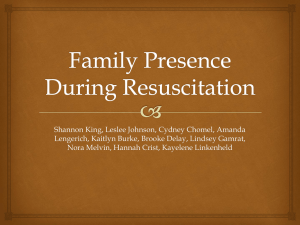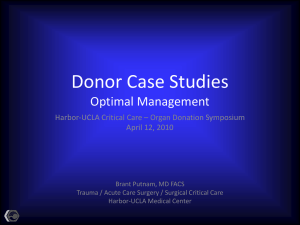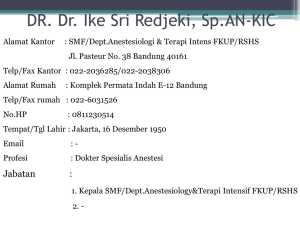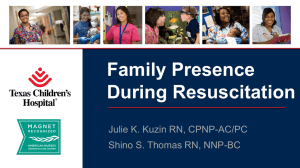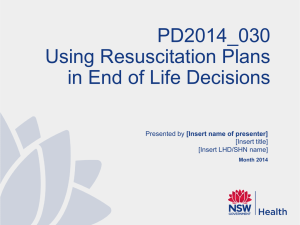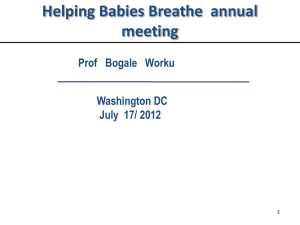Benefits of Family Presence During Resuscitation Efforts
advertisement
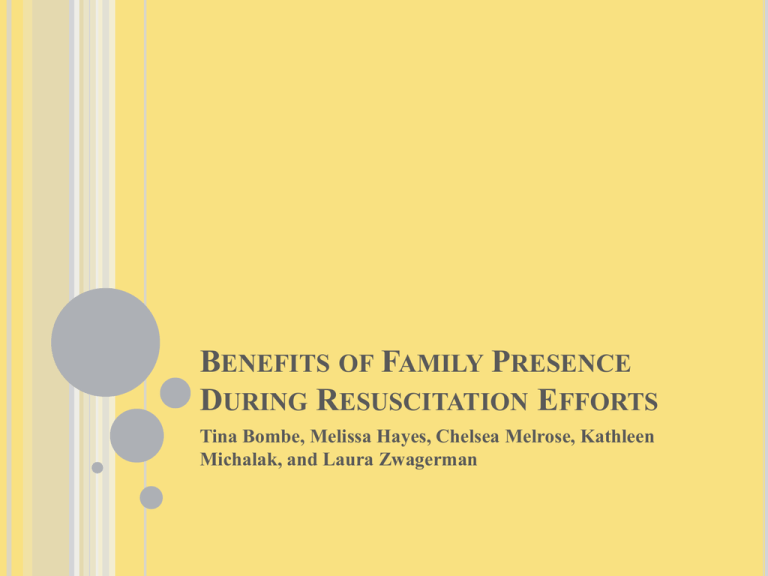
BENEFITS OF FAMILY PRESENCE DURING RESUSCITATION EFFORTS Tina Bombe, Melissa Hayes, Chelsea Melrose, Kathleen Michalak, and Laura Zwagerman FAMILY PRESENCE DURING RESUSCITATION Benefits have been debated for a long time Over 117 systematic reviews, research articles & metaanalyses were found Purpose of this EBP analysis is to consider the benefits of family presence during resuscitation efforts and the growing need for the development of written policies and guidelines to support this initiative. RESEARCH METHODS Performed a literature review of current quantitative and qualitative studies Analyzed the evidence to provide support of the data Applied the evidence into practice Suggested appropriate recommendations based on the evidence provided LITERATURE REVIEW Databases utilized: STAT!Ref, PubMed, Medline, & CINAHL Key Terms searched: family presence resuscitation, bedside resuscitation, resuscitation efforts, and benefits of family being bedside All articles chosen were relevant to the topic and supported by the subject matter identified. Five articles were selected ARTICLE #1: “USING RESEARCH TO DETERMINE SUPPORT FOR A POLICY ON FAMILY PRESENCE DURING RESUSCITATION” BY ROBERTA BASOL, KATHLEEN OHMAN, JOYCE SIMONES, KIRSTEN SKILLINGS Descriptive, correlational study Study asked two questions: What are the attitudes, concerns, and beliefs related to family presence during CPR and BIPS of *staff caring for patients from a variety of patient care units? Is there a relationship between the attitudes, concerns, and beliefs of *staff caring for patients from a variety of patient care units and certain demographic variables? “USING RESEARCH TO DETERMINE SUPPORT FOR A POLICY ON FAMILY PRESENCE DURING RESUSCITATION” BY ROBERTA BASOL, KATHLEEN OHMAN, JOYCE SIMONES, KIRSTEN SKILLINGS Distributed *surveys (1,402 surveys with 625 being returned) Most participants were: White 97.3% Female 80.3% RNs 78.8% Age range 23 to 81 years (Mean age of 42.6 years) After review of the surveys, a hospital-wide policy was recommended for family presence during resuscitation Policy was developed and implemented A follow-up survey is in development stages to identify response to policy change SIGNIFICANT FINDINGS The study conducted by Basol et al. (2009) found “positive experiences with family presence including the perception that families have made choice to stop efforts earlier than what the team may have done. There have been no negative experiences reported with the family presence” (p.243-244). RECOMMENDATIONS FROM STUDY After review of the benefits of family presence during resuscitation, Basol et al. (2009) recommended the “implementation of a hospital wide policy for family presence during resuscitation” (p.242). Findings supported the idea of families having the option to be present or not during resuscitation or bedside procedures (Basol et al., 2009, p.246). Findings also support development of hospital-wide policies giving families the option to be present during resuscitation. ARTICLE #2: “IDENTIFYING FACTORS INHIBITING OR ENHANCING FAMILY PRESENCE DURING RESUSCITATION IN THE EMERGENCY DEPARTMENT” BY JUDY DAVIDSON, RUTH BUENAVISTS, KEYNAN HOBBS, & KATHLEEN KRACHT Qualitative study Purpose: To explore inhibitors and enhancing factors surrounding the practice of allowing family presence in the emergency room. Data sources: interviews and observation 12 interviews of staff RNs and DRs were audiotaped and transcribed verbatim Barriers and Enhancing Factors included: staff emotions, personalizing the patient, seeing/hearing everything, closure, emotional support of the family and “if it were me”. SIGNIFICANT FINDINGS AND RECOMMENDATIONS The researchers results found there was “evidence in the literature to support the practice of family presence” however, “many staff felt unprepared to deal with the emotional burden” (Davidson et al., 2009, p.342). Recommendations: Staff education and support Provide a family liaison Consider environmental factors (ie small spaces, crowded conditions, lack of privacy) The researchers also suggested that drivers used in this study would “help to guide the policy revision to facilitate family presence at the bedside” (Davidson et al., 2009, p. 342). ARTICLE #3: “FAMILY PRESENCE DURING TRAUMA RESUSCITATION: READY FOR PRIMETIME?” BY MAE ANN PASQUALE, MICHAEL PASQUALE, LESLIE BAGA, SHERRINE EID, JANE LESKE Prospective, comparative study Assessed 50 adult family members, 25 who were present and 25 who were not present, with their severely injured adult family member. The studies “primary objective was to measure the effects of family presence during trauma resuscitation (FPTR) on family outcomes of anxiety, satisfaction and well-being in patients experiencing traumatic injury” (p.1092-1093). SIGNIFICANT FINDINGS AND RECOMMENDATIONS The study found that “given the option, family members desire to be present during resuscitation” (Pasquale et al., 2010, p.1097). The researchers concluded “family members present during trauma resuscitation suffered no ill psychological effects and scored equivalent to those family members who were not present on anxiety, satisfaction and wellbeing measures” (Pasquale et al., 2010, p. 1092). ARTICLE #4: “THE IMPACT OF EDUCATION ON PROVIDER ATTITUDES TOWARD FAMILY-WITNESSED RESUSCITATION” BY LORI FEAGAN, NANCY FISHER 2-phase quantitative, before/after study Phase 1: A convenience sample of DRs and RNs from 2 facilities were surveyed about their opinions and beliefs regarding family-witnessed resuscitation (FWR) Phase 2: Clinician subgroups in the community hospital were re-surveyed following an educational program that used EBP information. “THE IMPACT OF EDUCATION ON PROVIDER ATTITUDES TOWARD FAMILY-WITNESSED RESUSCITATION” BY LORI FEAGAN, NANCY FISHER Primary focus of this study: To evaluate local trends in provider attitudes toward offering the option of family presence during resuscitation (Feagan & Fisher, 2011) Test the effect of an educational program that used evidencebased information to improve clinician acceptance of family witnessed resuscitation (FWR) (Feagan & Fisher, 2011). SIGNIFICANT FINDINGS AND RECOMMENDATIONS Feagan and Fisher (2011) recommended “The success of adopting family presence guidelines may be greater if clinicians are presented with evidence-based data and ethical reasoning that address common provider concerns” (p. 238). The researchers also concluded “family presence during resuscitation may become a commonplace component of family-centered care” (p. 238). ARTICLE #5: “EMERGENCY NURSING RESOURCE: FAMILY PRESENCE DURING INVASIVE PROCEDURES AND RESUSCITATION IN THE EMERGENCY DEPARTMENT” DEVELOPED BY 2009 ENA EMERGENCY NURSING RESOURCE DEVELOPMENT COMMITTEE Comprehensive review and analysis of current data from an evidence based perspective The researchers provided a thorough review and critical analysis of 117 research studies regarding the benefits of family presence during resuscitation. SIGNIFICANT FINDINGS AND RECOMMENDATIONS Based on the researchers literature review, the following evidence was found: Evidence that patients would prefer to have their family members present during resuscitation Evidence that family members wish to be offered the option to be present Evidence that family member presence does NOT interfere with patient care Evidence that health care professionals support the presence of a designated liaison, that is assigned to provide explanations and comfort family members who are present ENA’s Recommendation: family member presence during invasive procedures or resuscitation should be offered as an option to appropriate family members and should be based on written institution policy (p.5). EVIDENCE IN PRACTICE Family presence during resuscitation: is it beneficial? The study by Pasquale et al., 2010 reviewed collected data over a 5 month period from 50 family members (25 present and 25 not present during trauma resuscitation). Of those present during resuscitation efforts, 18 of the 25 family members responded positively to the experience. The researchers found that no one from this group responded negatively. Survey results suggested that family members had a better understanding of the seriousness of the situation as a result of being present during resuscitation efforts. EVIDENCE IN PRACTICE It was found during a critical review of 20 articles (as examined by Bourdeaux et al.) that family presence during resuscitation efforts in the emergency department: When given the option, family members choose to be present during these situations. This study also revealed that family members felt as though their presence was beneficial to the patient. Note: Nurses in this study were more favorable toward family presence than physicians. EVIDENCE IN PRACTICE Should hospitals have a written policy regarding family presence during resuscitation? Although professional organizations and critical care experts support family presence during resuscitation, only 5% of critical care units in the United States have written policies (Basol et al., 2009). Prior to the development of a policy, both the benefits and possible negative effects must be considered. EVIDENCE IN PRACTICE Perceived barriers to family resuscitation Studies show that there is some reluctance of emergency room staff to allow family presence during resuscitation and emergency procedure efforts. Perceived barriers include: fears that family members may interfere; poor staff performance will be observed; family members will hamper the staff’s performance; family will misinterpret the team’s activities; future litigation may occur; the room may be overcrowded; there may be negative psychological effects to the family; families would be more likely to complain that not enough was done/too much was done; the resuscitation procedure was stopped too soon or not carried on long enough; physicians or RNs may be uncaring in their attitudes; inappropriate remarks could be made (Basol et al., 2009). EVIDENCE OF PRACTICE Benefits of family presence resuscitation: fosters great appreciation for code efforts; enhances family understanding of patient’s condition; reduces family guilt and anxiety; focuses staff attention on patients’ privacy and dignity; encourages professional behavior among staff; helps staff provide more holistic care (Basol et al., 2009). RECOMMENDATIONS Each article researched agreed on this: DEVELOP A HOSPITAL POLICY Policy Development Recommendations: Consider potential barriers Provide education to staff Assess attitudes, beliefs REFERENCES Basol, R., Ohman, K., Simones, J., & Skillings, K. (2009). Using research to determine support for a policy on family presence during resuscitation. Dimensions Of Critical Care Nursing, 28(5), 237-249. doi:10.1097/DCC.0b013e3181ac4bf4 Davidson, J. E., Buenavista, R., Hobbs, K., & Kracht, K. (2011). Identifying Factors Inhibiting or Enhancing Family Presence During Resuscitation in the Emergency Department. Advanced Emergency Nursing Journal, 33(4), 336-343. doi:10.1097/TME. 0b013e318234e6a0 Egging, D., Crowley, M., Arruda, T., Proehl, J., Walker-Cillo, G., Papa, A., Li, S., & Walsh, J. (2009, December). Emergency nursing resource: Family presence during invasive procedures and resuscitation in the emergency department. Retrieved from http://www.ena.org/IENR/ENR/Documents/FamilyPresenceENR.pdf Feagan, L. M., & Fisher, N. J. (2011). The Impact of Education on Provider Attitudes Toward Family-Witnessed Resuscitation. JEN: Journal Of Emergency Nursing, 37(3), 231239. doi:10.1016/j.jen.2010.02.023 Pasquale, M., Pasquale, M., Baga, L., Eid, S., & Leske, J. (2010). Family presence during trauma resuscitation: ready for primetime?. Journal Of Trauma, 69(5), 1092-1100. doi:10.1097/TA.0b013e3181e84222

